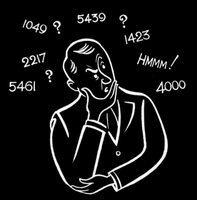Credit Spreads & Volatility
 It has been about a month or so since I last touched on the topic of Implied Volatility. Last week we talked about credit spreads, and today I am in the mood to merge the two topics together. I have heard many traders say that they pick a trade based on the implied volatility of the underlying. Touché. At the same time I hear others try to generalize strategies saying that if Implied Volatility is high (options are expensive) then you want to be an option seller (credit spreads). If Implied Volatility is low (options are cheap) then you want to be a buyer (debit spreads). Let's go through an example. Assume I was going to sell a bull put spread on Apple Computers: AAPL. Let's really examine this trade closely. Keep in mind Apple was at 91.00 at the time of this post.
It has been about a month or so since I last touched on the topic of Implied Volatility. Last week we talked about credit spreads, and today I am in the mood to merge the two topics together. I have heard many traders say that they pick a trade based on the implied volatility of the underlying. Touché. At the same time I hear others try to generalize strategies saying that if Implied Volatility is high (options are expensive) then you want to be an option seller (credit spreads). If Implied Volatility is low (options are cheap) then you want to be a buyer (debit spreads). Let's go through an example. Assume I was going to sell a bull put spread on Apple Computers: AAPL. Let's really examine this trade closely. Keep in mind Apple was at 91.00 at the time of this post.AAPL DEC 85 PUT ASK .65 D -.16 G .04 T .04 V .05 IV 32.72%
AAPL DEC 90 PUT BID 2.00 D .43 G -.06 T .06 V -.08 IV 31.55%
Both of these options are out-the-money. No intrinsic value involved here, which makes these premiums 100% time value. Assume we have successfully sold this spread, and we are short this position. Let's look at it as a whole....
AAPL DEC 85/90 Vertical CR 1.35 D .25 G -.02 T .10 V -.03 IV 32.13%
This might be confusing, but I am giving you the net position from the offsetting greeks (D=Delta G= Gamma T=Theta V= Vega IV= Implied Volatility). For example the negative delta on the long put offset by the positive delta on the short put equals a small, but positive delta position. Almost the equivalent sensitivity of an OTM option. You are also in a negative gamma position, since you are short a higher gamma than you have purchased. You are long theta, which is the most important piece of this trade. Now going back to my correlation with Implied Volatility...the reason the new IV is different is because I am using the average implied volatility of the two strikes. Notice how we have a neutral/negative vega though! For every 1% increase in IV...we lose three cents. Hardly sensitive to change in volatility right! You can take over priced or under priced options and typically they offset the impact of implied volatility. Going back to the foundation of this trade, you are not sensitive to IV since you have bought an expensive/cheap option and you've sold one as well.
I hope this sheds light, rather than casts a shadow. If you have questions I will montior the chat. Throw some chatter out there.








Jeff,
That was pretty informative. Spreads are plays on strikes/time and not so much volatility. That's cool. Thanks, Jeff.
Posted by Anonymous |
11/28/2006 05:11:00 PM
Anonymous |
11/28/2006 05:11:00 PM
I agree with you Jeff. I think one reason to enter the high IV trade is that,even though they are neutral on IV, just that the options are priced high so the reward would be high (if we short on ATM and long on OTM)
thanks,
raaj
Posted by Anonymous |
11/28/2006 05:11:00 PM
Anonymous |
11/28/2006 05:11:00 PM
I aggree. There is not a real incentive to sell high iv spreads if you keep the strikes close together. Using the greeks to understand your position is usefull when you are measuring your risk.
Thanks,
Posted by Anonymous |
11/28/2006 06:01:00 PM
Anonymous |
11/28/2006 06:01:00 PM
All things being even, why would I take a high IV Spread, over a low IV Spread. The market maker is not putting IV out there on a whim. If the spread has a high IV than the market is expecting a bigger move (MORE RISK TO ME). If the IV is low the market maker thinks the water is calm. The reason you should trade spreads is because you think there will be little price movement also. If I thought the price was going to move a bunch I could either lose a bunch buying the spread and having price move against me, or make alot if I buy a directional option and am right. Just my opinion, but what do I know I took a bath on TXRH options today and yesterday.
Posted by Anonymous |
11/28/2006 06:21:00 PM
Anonymous |
11/28/2006 06:21:00 PM
Say Jeff,
Shouldn't the combined theta be the difference, and not the sum, of the individual thetas? Great blog, BTW.
Posted by Anonymous |
11/28/2006 07:39:00 PM
Anonymous |
11/28/2006 07:39:00 PM
Anonymous...
Thanks for the question about theta. Whether you are long or short an option, either position loses value for each passing calendar day. The sum of both theta's in this trade tell you how much both options will lose in value per each passing day.
JK
Posted by Option Addict |
11/28/2006 08:51:00 PM
Option Addict |
11/28/2006 08:51:00 PM
I've been trading credit spreads for years on indices's and stocks. The IV picture makes a HUGE difference on WHERE I can place my spreads in relation to price, probability and return. Also - an IV collapse will move me to profitability much sooner with the short vega in the spread. High IV can create a HUGE edge... as we have just witnessed in the major indexes. Under normal IV scenarios, I can get a decent return about 150 off the NDX spot.. Recent High IV allowed me to go 250 points away. The markets recently bounced, the IV fell, and I booked 60% of the profits in one week. Thanks IV!
Posted by Anonymous |
8/22/2007 11:24:00 PM
Anonymous |
8/22/2007 11:24:00 PM